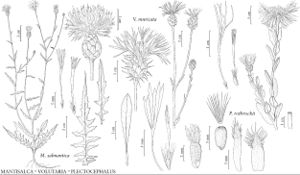Plectocephalus
in R. Sweet, Brit. Fl. Gard., ser. 2, 1: plate 51. 1830.
| Taxon | Illustrator ⠉ | |
|---|---|---|
 | Mantisalca salmantica Volutaria muricata Plectocephalus rothrockii | John Myers John Myers John Myers |
Annuals, 30–200 cm, not spiny. Stems erect, branched. Leaves basal and cauline; petiolate or sessile; blade margins entire or dentate, faces puberulent, minutely glandular-punctate. Heads radiant, borne singly or in open cymiform arrays. Peduncles fistulose. Involucres ovoid to hemispheric or campanulate, 30–60 mm diam. Phyllaries many in 8–10+ series, unequal, narrow, bodies linear, appressed, entire, apices expanded into erect to spreading, narrowly triangular, fringed appendages. Receptacles flat, epaleate, bristly. Florets many, peripheral neuter; corollas pink to purple, ± zygomorphic, elongate and expanded; inner fertile, corollas pink, purple, cream, or pale-yellow, zygomorphic or actinomorphic, ± bent at junction of tubes and throats, tubes elongate, very slender, throats cylindric, lobes linear; anther bases tailed, apical appendages oblong; style-branches: fused portions with minutely hairy nodes, distinct portions minute. Cypselae: basal attachment scars oblique (with small elaiosome on one side), obovoid or ± barrel-shaped, ± compressed, weakly ribbed, glabrous or puberulent with 2-celled hairs; pappi readily falling, of 1–3 series of stiff, minutely barbed bristles. x = 13.
Distribution
North America, Mexico, South America, Africa
Discussion
Species 4 (2 in the flora).
Molecular phylogenetic studies have been informative regarding the relationships of members of Cynareae, Centaureinae. Centaurea as traditionally recognized is polyphyletic. Plectocephalus is part of the basal grade in Centaureinae and is not closely related to Centaurea in a narrow sense (A. Susanna et al. 1995). Morphologically Plectocephalus is difficult to separate from the more derived and highly diverse Centaurea. Plectocephalus cypselae have obliquely basal attachment scars and the hilum of the seeds is basal. Centaurea cypselae have lateral attachment scars and hilum of the seed is lateral. The ovaries of Plectocephalus initially have 2-celled hairs; these may be absent from mature cypselae. Centaurea produces only 1-celled hairs on ovaries.
Selected References
Lower Taxa
Key
| 1 | Mid phyllaries with (4–)5–7(–8) pairs of lobes, distally light to dark stramineous. | Plectocephalus americanus |
| 1 | Mid phyllaries with (9–)10–13(–15) pairs of lobes, distally medium brown to dark brown. | Plectocephalus rothrockii |
"fine" is not a number.